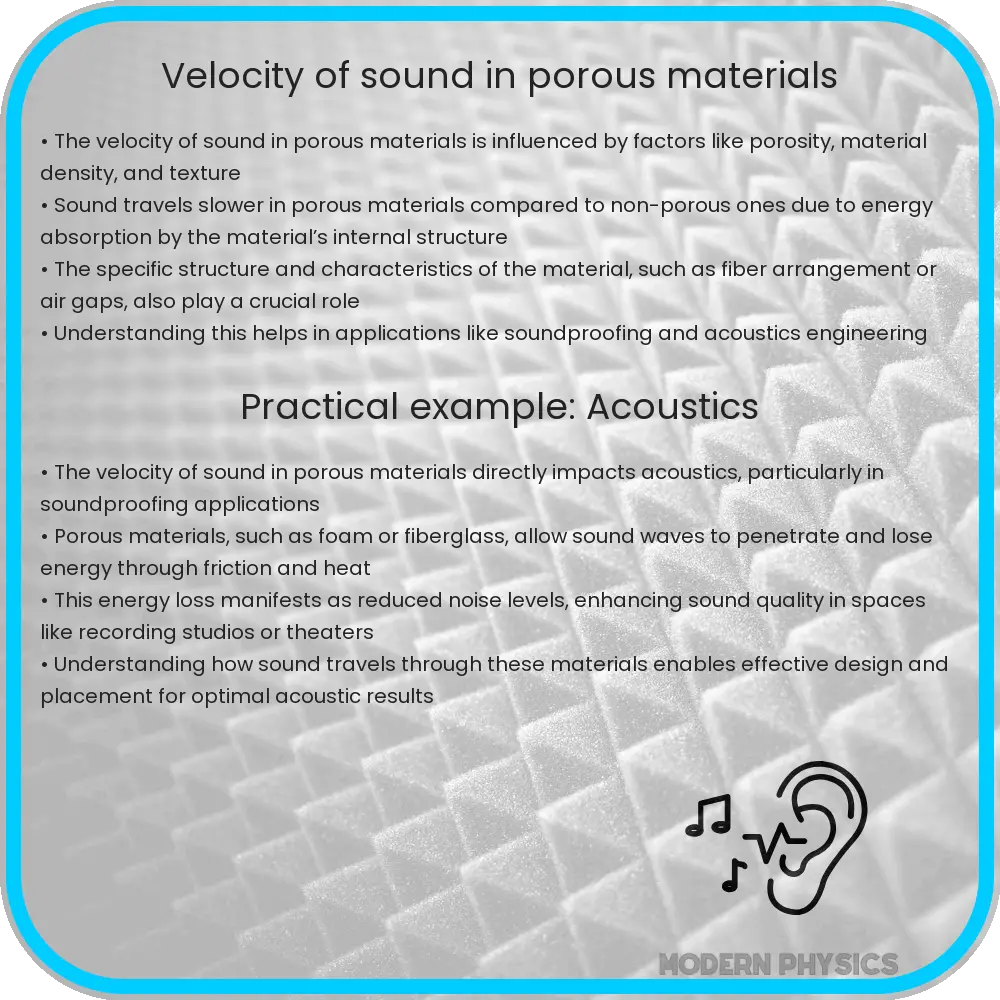Explore how sound velocity in porous materials is influenced by their structural properties and interactions with sound waves.

Understanding the Velocity of Sound in Porous Materials
Sound velocity in materials is a fundamental property that has profound implications in various fields such as engineering, construction, and acoustics. When we explore sound behavior in porous materials, we delve into a more complex scenario, largely due to the interactions of sound waves with the structure of these materials. These interactions significantly affect the transmission, absorption, and reflection of sound.
Basics of Sound Velocity
Sound velocity, or the speed at which sound travels through a medium, is influenced by the medium’s physical properties, including density and elasticity. In general, the formula to determine the speed of sound in a homogeneous, non-porous material is given by:
v = sqrt(E / ρ)
where v is the sound velocity, E represents the elastic modulus (stiffness) of the material, and ρ is the density. However, this formula must be modified when dealing with porous materials.
Acoustic Properties of Porous Materials
Porous materials are characterized by their permeable nature, containing pores or voids within their structure. The presence of these voids alters sound propagation in several ways. Most notably:
- The effective density and elastic properties are different from those in non-porous materials
- Sound waves are partially absorbed when passing through these materials, dissipating energy primarily by viscous and thermal losses
- The interaction between the sound waves and the solid structure of the material adds complexity to the wave propagation mechanism
Due to these factors, estimating the velocity of sound in porous materials requires an understanding of additional parameters such as porosity, tortuosity, and flow resistivity.
Modeling Sound Velocity in Porous Materials
Several models exist to predict the acoustic behavior of porous materials. One widely used model is based on Biot theory, which considers both the elastic frame and the presence of air in the pores. The Biot model provides a comprehensive framework that accounts for the viscoelastic properties of the frame, as well as the viscous and thermal interaction of the air in the pores.
According to Biot’s theory, the speed of sound depends not only on the elastic and mechanical properties mentioned in simpler models but also on parameters like:
- Porosity (φ): The ratio of the volume of voids in a material to the total volume.
- Tortuosity (α): A factor that describes the complexity of the path through the porous structure.
- Flow resistivity (σ): The resistance to the flow of air through the material, which impacts energy dissipation and absorption characteristics.
These factors make the formula for sound velocity in porous materials more complex, incorporating both the fluid and solid interactions within the material:
v_p = sqrt((B + 4/3 * G) / (ρ(1 + αφ)))
Here, B and G are the bulk and shear moduli, respectively.
Applications of Sound in Porous Materials
Understanding sound propagation through porous materials has practical applications in various industries. For instance:
- Acoustic Engineering: Designing soundproofing materials and acoustic panels, particularly in building construction and automotive industries.
- Environmental Science: Developing efficient noise barriers to minimize environmental noise pollution.
- Material Science: Tailoring materials with specific sound absorption properties for specialized uses.
In all these applications, the knowledge of how sound interacts with porous materials helps engineers and designers create more effective, functionally relevant products and solutions tailored to the acoustic needs of different environments.
Challenges in Measuring Sound Velocity in Porous Materials
Accurately measuring the sound velocity in porous materials presents several challenges. The heterogeneity of these materials means that sound waves can scatter, reflect, and be absorbed unpredictably. This complicates the setup and interpretation of experimental data since the results can vary based on factors such as the material’s composition, pore size distribution, and moisture content.
- Experimental Setup: Precise and consistent experimental conditions are required to obtain reliable sound velocity data. Variations in temperature and humidity can affect the results.
- Data Interpretation: Due to the complex behavior of sound in these materials, advanced computational models are often necessary to interpret experimental data and predict sound behavior under various conditions.
Future Directions in Research
Future research in the field of sound velocity in porous materials aims to refine the models and measurement techniques we currently have. Enhanced understanding and technology can lead to better predictive models that take into account the anisotropic properties and the nonlinear behavior of these materials under different loading conditions. These improvements could further optimize the design and manufacturing of acoustic materials, making them more effective and versatile in their applications.
- Improved Materials: Development of materials with tailor-made porosity and elastic properties to achieve desired sound characteristics.
- Advanced Simulation Tools: Creation of more sophisticated numerical simulation tools that can accurately model sound wave propagation in complex materials structures.
- Interdisciplinary Approaches: Collaboration across physics, engineering, and materials science to innovate new solutions for sound management.
Conclusion
Exploring the velocity of sound in porous materials offers fascinating insights into how sound interacts with complex structures. While traditional models provide a basis for understanding, the unique properties of porous materials necessitate a deeper, more nuanced approach. Through the application of theories like Biot’s, and ongoing advancements in experimental and computational techniques, engineers and scientists continue to enhance our ability to design materials that effectively manage sound. Whether it’s improving the acoustics of a concert hall, designing quieter automotive components, or developing materials for noise control in urban environments, the study of sound velocity in porous materials plays a critical role in our quest to create quieter, more harmonious environments.
